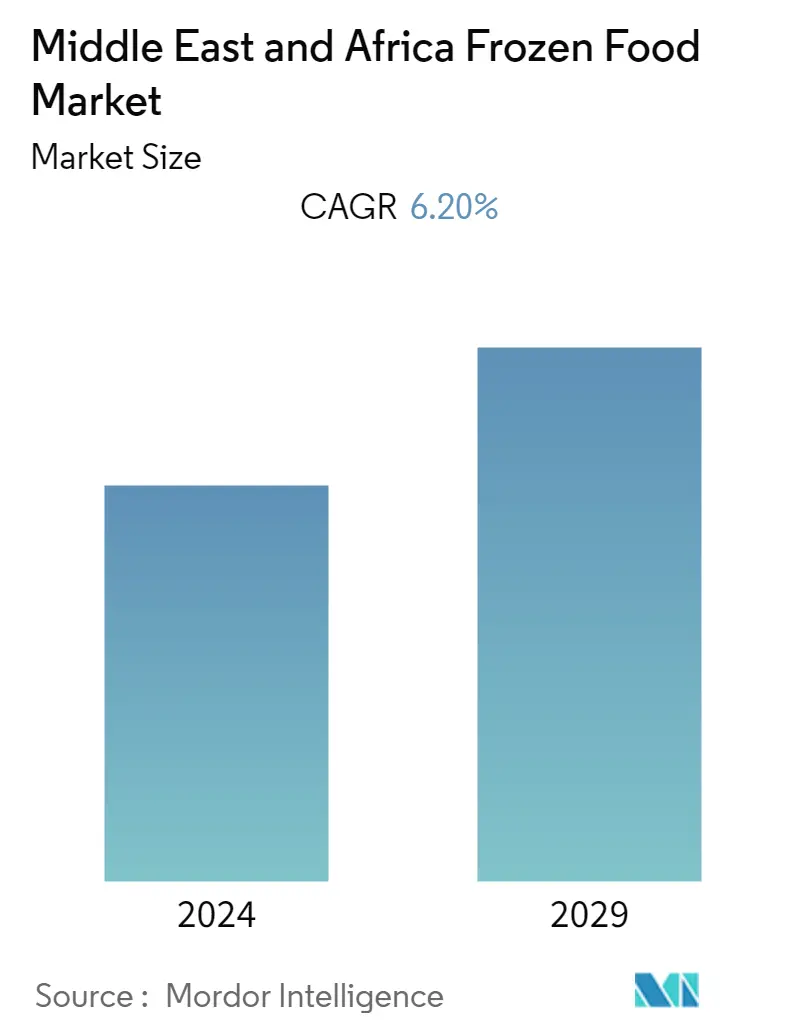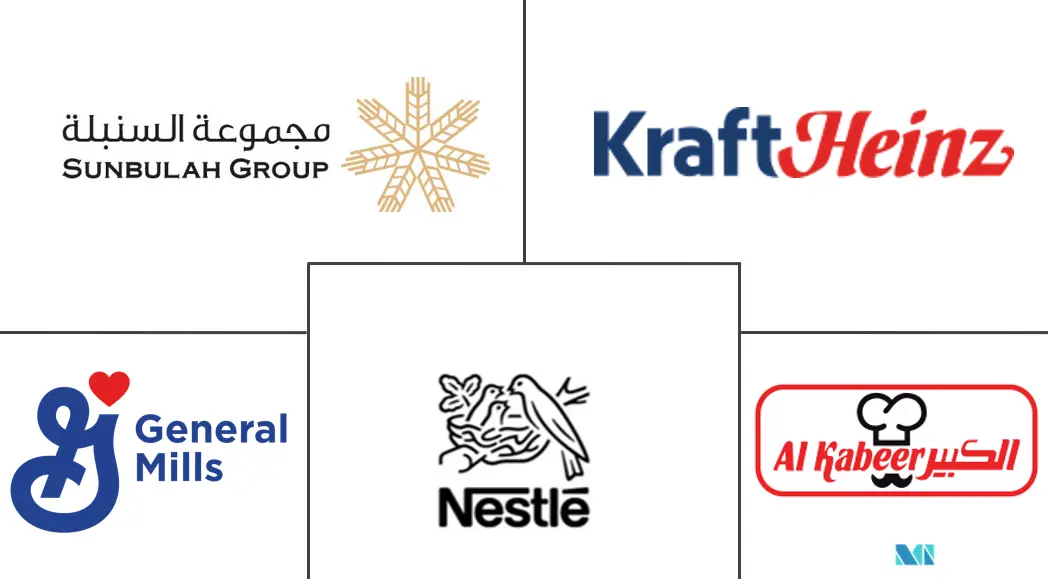Market Size of Middle East & Africa Frozen Food Industry

| Study Period | 2019 - 2029 |
| Base Year For Estimation | 2023 |
| Forecast Data Period | 2024 - 2029 |
| Historical Data Period | 2019 - 2022 |
| CAGR | 6.20 % |
| Market Concentration | Low |
Major Players
*Disclaimer: Major Players sorted in no particular order |
MEA Frozen Food Market Analysis
The Middle East & Africa Frozen Food market is projected to register a CAGR of 6.2% during the forecast period, 2022-2027.
Rapid urbanization, lack of time to cook, increasing demand for convenient food, improved living standards, and the presence of a high percentage of expatriates are driving the demand for frozen food in the region. Millennials and the Gen Z population are more inclined toward frozen foods owing to their willingness of trying new varieties of convenience food such as frozen snacks and frozen ready meals.
The attributes of frozen foods such as easier storage, preserved nutrition at peak ripeness, extended shelf life, and reduction in food waste are boosting the growth of frozen food sales in the region. Additionally, the increasing number of modern retail formats in the country and the availability of a greater variety of frozen ready-to-eat meals have attracted urban consumers who are seeking packaged food products due to their fast-paced lifestyle, thereby leading to a noticeable increase in demand.
During the COVID-19 pandemic, the demand for non-perishable food products such as frozen food witnessed a huge surge in consumer demand, mainly due to the stockpiling nature of the consumers, caused by extended lockdowns.
MEA Frozen Food Industry Segmentation
Frozen food is defined as food products that are preserved under low temperatures and used over a long period. The frozen food market is segmented by product type, product category, distribution channel, and geography. By product type, the market is segmented into frozen fruits and vegetables, frozen snacks, frozen seafood, frozen meat and poultry, frozen desserts, and other product types. By product category, the market is classified as ready-to-eat, ready-to-cook, and others. By distribution channel, the market is segmented into supermarkets/hypermarkets, convenience stores, online retail channels, and other distribution channels. It provides an analysis of the frozen food market in the emerging and established markets across the region, including United Arab Emirates, Saudi Arabia, South Africa, and Rest of Middle East and Africa. The report offers market size and forecasts in value (USD million) for the above segments.
| By Product Type | |
| Frozen Fruit and Vegetable | |
| Frozen Poultry and Seafood | |
| Frozen Prepared Food | |
| Frozen Dessert | |
| Frozen Snack | |
| Others |
| By Distribution Channel | |
| Supermarket/Hypermarket | |
| Grocery Stores | |
| Convenience Store | |
| Online Retailer | |
| Others |
| By Geography | |
| United Arab Emirates | |
| Saudi Arabia | |
| South Africa | |
| Rest of Middle-East and Africa |
Middle East & Africa Frozen Food Market Size Summary
The Middle East & Africa frozen food market is experiencing significant growth, driven by factors such as rapid urbanization, a busy lifestyle, and the increasing demand for convenient food options. The region's high percentage of expatriates and the preferences of millennials and Gen Z for new varieties of convenience foods, like frozen snacks and ready meals, are further propelling market expansion. The benefits of frozen foods, including easier storage, preserved nutrition, extended shelf life, and reduced food waste, are appealing to consumers. The rise of modern retail formats and the availability of diverse frozen ready-to-eat meals cater to urban consumers seeking quick meal solutions. The COVID-19 pandemic also boosted demand as consumers stockpiled non-perishable foods during lockdowns. The growing employed population, particularly in countries like Qatar, is increasingly opting for frozen meals due to hectic work schedules and the convenience of longer shelf life compared to perishable foods.
In Saudi Arabia, the demand for quick and easy-cook meal solutions is on the rise, driven by the increasing number of double-income families. The market is characterized by a strong consumer inclination towards frozen desserts, ready-to-eat meals, and frozen meat products. The country's reliance on imports to meet local demand, coupled with high retail stability, makes frozen food products a popular choice. The market is fragmented and competitive, with regional and international players like Sunbulah Group, General Mills Inc., and Al Kabeer Group investing in research and development to innovate their offerings, including halal-certified and organic frozen foods. Partnerships between foreign brands and regional companies are common for distribution across the region. Recent expansions and product launches, such as Seara's halal portfolio in Saudi Arabia and Al Islami Foods' new dough category, highlight the ongoing efforts to meet the growing consumer demand for frozen food products.
Middle East & Africa Frozen Food Market Size - Table of Contents
-
1. MARKET DYNAMICS
-
1.1 Market Drivers
-
1.2 Market Restraints
-
1.3 Porter's Five Force Analysis
-
1.3.1 Threat of New Entrants
-
1.3.2 Bargaining Power of Buyers/Consumers
-
1.3.3 Bargaining Power of Suppliers
-
1.3.4 Threat of Substitute Products
-
1.3.5 Intensity of Competitive Rivalry
-
-
-
2. MARKET SEGMENTATION
-
2.1 By Product Type
-
2.1.1 Frozen Fruit and Vegetable
-
2.1.2 Frozen Poultry and Seafood
-
2.1.3 Frozen Prepared Food
-
2.1.4 Frozen Dessert
-
2.1.5 Frozen Snack
-
2.1.6 Others
-
-
2.2 By Distribution Channel
-
2.2.1 Supermarket/Hypermarket
-
2.2.2 Grocery Stores
-
2.2.3 Convenience Store
-
2.2.4 Online Retailer
-
2.2.5 Others
-
-
2.3 By Geography
-
2.3.1 United Arab Emirates
-
2.3.2 Saudi Arabia
-
2.3.3 South Africa
-
2.3.4 Rest of Middle-East and Africa
-
-
Middle East & Africa Frozen Food Market Size FAQs
What is the current Middle East & Africa Frozen Food Market size?
The Middle East & Africa Frozen Food Market is projected to register a CAGR of 6.20% during the forecast period (2024-2029)
Who are the key players in Middle East & Africa Frozen Food Market?
General Mills Inc., Nestle S.A., Al Kabeer Group, Sunbulah Group and Kraft Heinz Company are the major companies operating in the Middle East & Africa Frozen Food Market.

